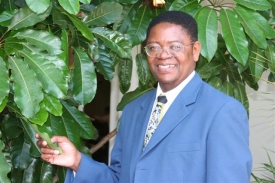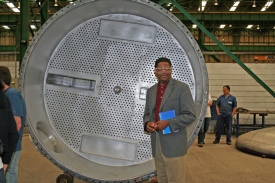 Filed by Erika Engelhaupt
Filed by Erika Engelhaupt
When it comes to solving energy problems, Foster Agblevor thinks big. As a bioresource engineer at Virginia Polytechnic Institute and State University, he designs chemical and industrial processes that make the most of natural resources. His goal: to create energy and biobased products while making waste a thing of the past. He’s been an energetic member of our traveling group in Brazil, with a quick smile and lots of questions as he looks for opportunities to work with Brazilian scientists and companies.
“There is no such thing as waste in biomass,” Agblevor says. “As soon as you find a use for something, it is a resource.” All that’s required is a shift in point of view, he adds.
One project recently took Agblevor to Egypt to find resources in an unusual problem. When he arrived, Agblevor was amazed to see lush green crops growing in the desert thanks to advanced irrigation techniques. The problem, scientists there told him, is that crop residues won’t decompose in the dry climate. Residues pile up, and farmers have to either add more of their valuable water to get them to rot or burn them. Burning has created terrible air quality, and the piles are a waste problem.
First, Agblevor suggested using the biomass to make fuel, but the scientists in Egypt weren’t particularly interested in a new fuel supply. Next, Agblevor proposed that they could turn these residues into a variety of biobased products. The idea was a hit. The team is working now to turn rice straw, banana stems, and cotton gin waste into microcrystalline cellulose, which can be used in pharmaceuticals, cosmetics, casting molds, and food.
Agblevor discussed this and other facets of his work when he outlined biomass conversion processes and challenges on Wednesday at a joint ACS and Brazilian Chemical Society (SBQ) biofuels symposium, which precedes the annual SBQ conference. The symposium focused on biomass conversion to biofuels and other materials, and it took place in the picturesque resort town of Águas de Lindóia, about 180 km north of São Paulo.
“We have to think beyond fuels,” Agblevor said during his presentation. “We have to think of the whole system.” In ethanol production, that means finding ways to make the most of residues such as bagasse (leftover stems) and of residues from the distilling process. Many other leftovers, such as manure and forestry residues, hold promise too. Using lignocellulosic biomass, the “tough stuff” of plants, remains a challenge. One approach discussed at this meeting is pyrolysis (oxygen-free heating) to break these materials down.
For example, Agblevor described pyrolyzing chicken litter (manure) to create a slow-release fertilizer. The new fertilizer replaces direct applications of high-phosphorus litter to fields, which can cause a phosphorus pulse that leads to eutrophication problems.Another approach to using lignocellulosic materials is to thermochemically break them down into a mixture of carbon monoxide and hydrogen known as syngas. This gas mixture can then be combined with catalysts to build a wide variety of compounds, including alcohols and hydrocarbons such as diesel.
Agblevor says the trip to Brazil has been fruitful. Brazil is a country “rich in biomass and in expertise,” he says, and he was particularly impressed with the level of integration among biofuel market sectors in Brazil (see C&EN Senior Editor Steve Ritter’s blog entry “Factories To Factories”). The company Dedini Indústrias de Base, for example, has the engineering expertise to both design and build plants. The company can even build plants such as its new Barralcool facility that produces bioethanol, biodiesel, and bioelectricity.
 Agblevor (right, at Dedini with part of a distillation unit) hopes to help bring this kind of systems thinking home to the U.S. “We want to solve these [energy] problems in an environmentally friendly way,” Agblevor says. “I don’t want to solve one problem and create another.” When using crop residues for fuels and products, for example, he cautioned that removing too much biomass would reduce levels of soil organic matter, leading to lower crop yields.
Agblevor (right, at Dedini with part of a distillation unit) hopes to help bring this kind of systems thinking home to the U.S. “We want to solve these [energy] problems in an environmentally friendly way,” Agblevor says. “I don’t want to solve one problem and create another.” When using crop residues for fuels and products, for example, he cautioned that removing too much biomass would reduce levels of soil organic matter, leading to lower crop yields.
Homegrown solutions that meet regional needs and account for local growing conditions are best, Agblevor says. He hails from Ghana, a country that currently faces a huge garbage disposal problem. Always an optimist, Agblevor hopes to help turn this problem into yet another resource.
Foster Agblevor,
This is the exact practical approach needed. I have a book printed in 1917 entitled “The Treasures of Coal Tar” by Alexander Findlay. In this incredible book, the value of the waste products of coal distillation for fuel oil and coal gas was discussed in a brilliant way. Alexander describes the extraction of textile dyes, perfumes, medicines, explosive ingredients, and others. He describes clearly the backwardness in the recognition of the value of science in the separation processes. This led to severe shortages in many products for the countries which relied on many products which could have been available from coal tar byproducts during WWI as they had plentiful coal supplies. The very goods they desperately needed and others simply excluded due to supply issues, were right in front of them and yet they were burning them and complaining of the smoke. While much of the needed science was still new, it was available.
Ninety years later we still grind the coal and burn it then complain of the nitrogen compounds, sulfur and carbonaceous emissions. Although certainly, products are made of coal other than heat for electricity production, it is still far more common to ignore the vast number of products which could be extracted, providing a cleaner energy source as the byproduct while providing as you so correctly say, an overall solution to energy, and the environmental issues.
Please continue to express your research findings and let more people know through journalism, and the media in general, how the proper extraction of certain moieties can benefit society while allowing that portion of the biomass or other source of energy to be used wisely and of course with the least environmental impact.
Thank you,
Darell Engelhaupt
Sr Research Scientist
University of Alabama
Huntsville, AL
Rising demand for food in China, India, and other rapidly growing developing countries is the result of reducing poverty and that, of course, is a good thing! Over the longer run, a big part of the answer is for donors and developing country governments to invest more in improving agricultural productivity, as recommended by World Bank President Zoellick in his speech at the Center last week. In terms of what can be done now, this post focuses on the food aid problem and the need to reform US policy. A…